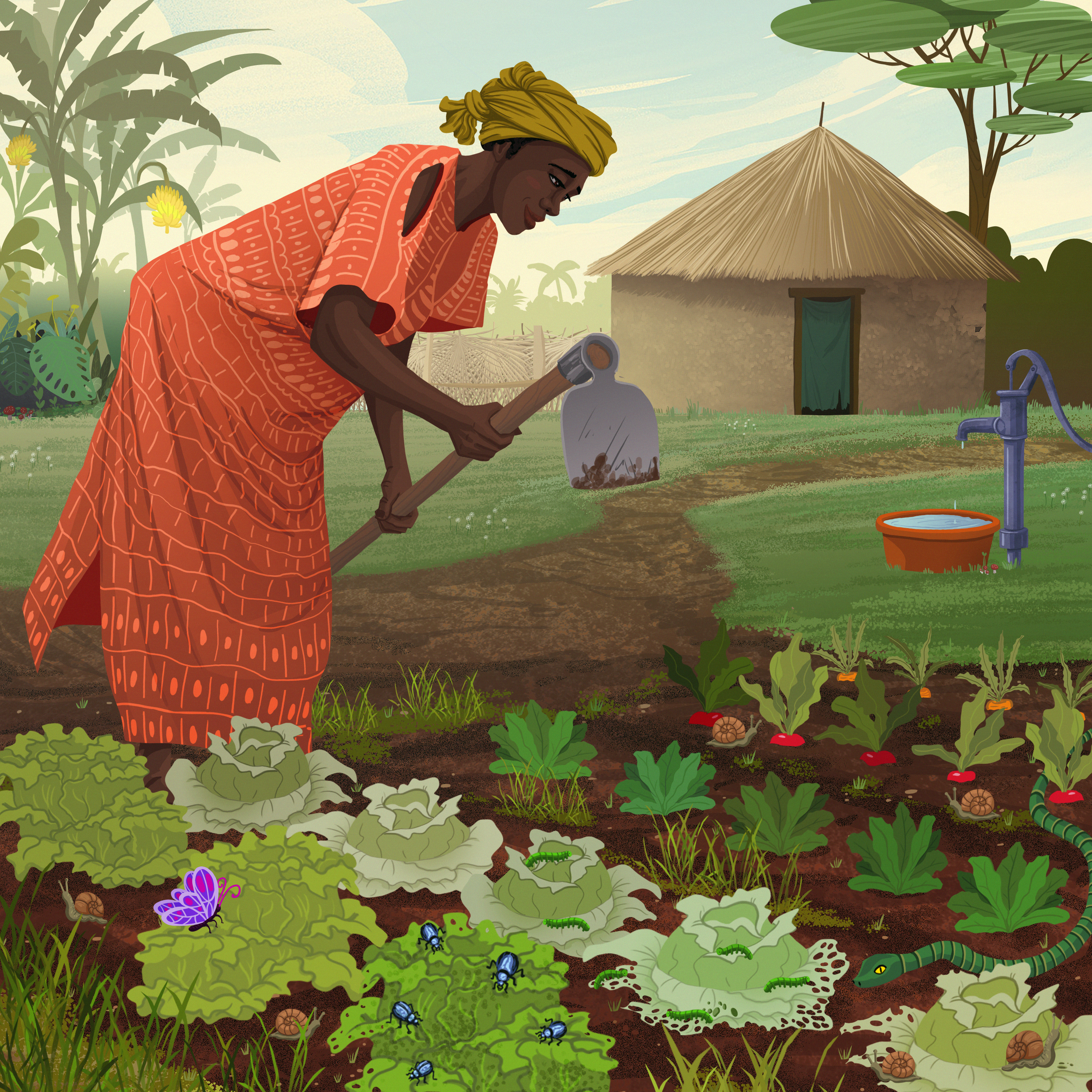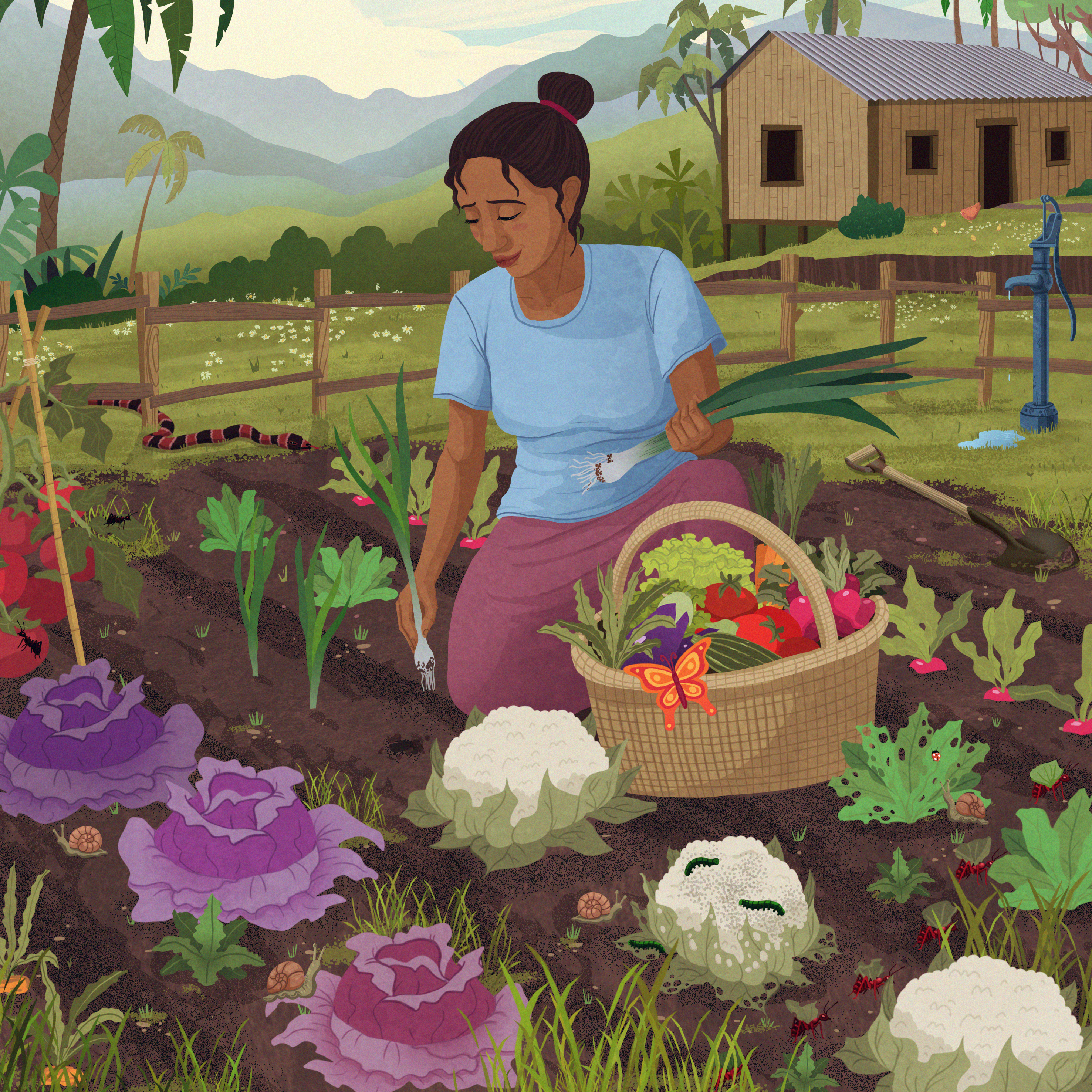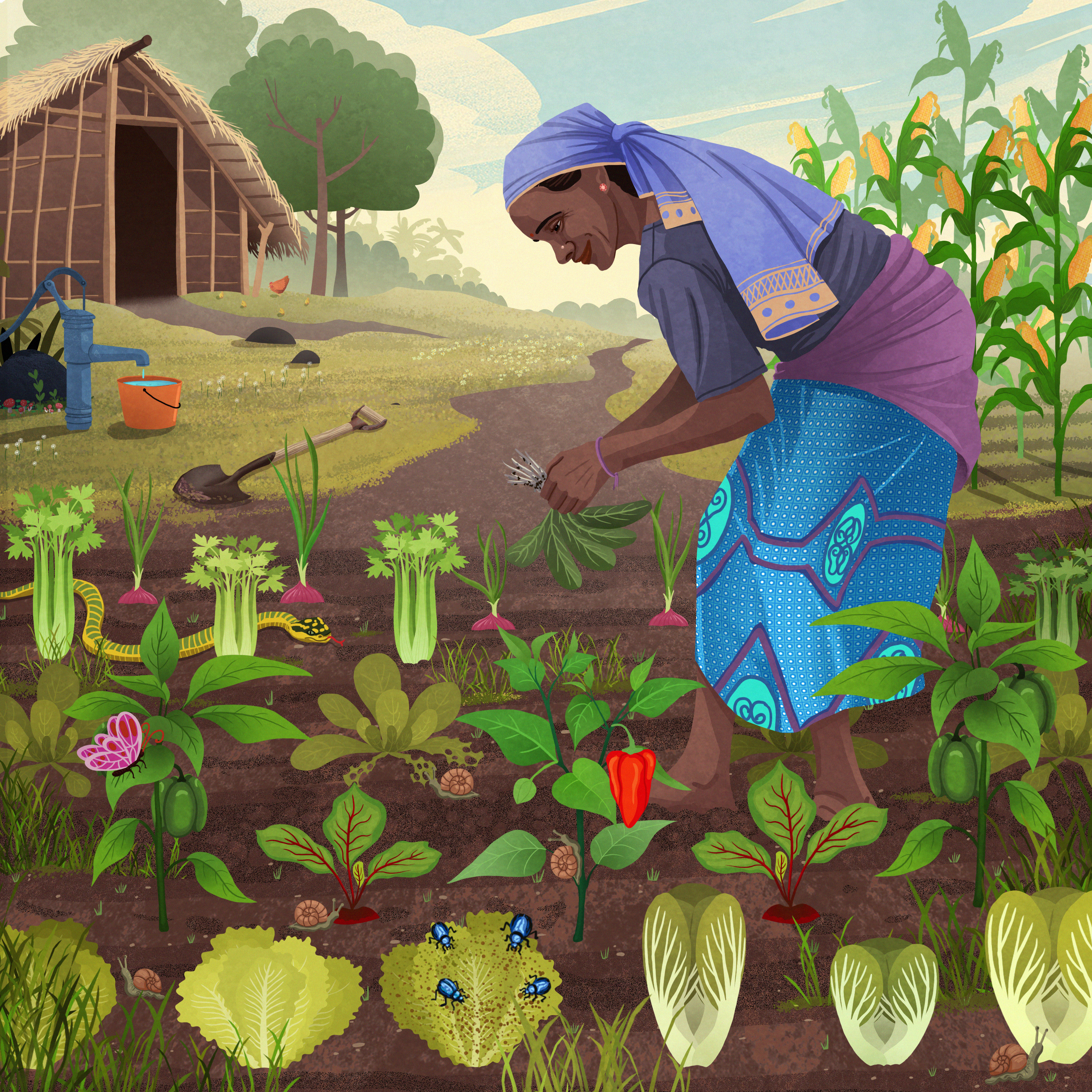Global Child Protection Parenting Curriculum
Year 2, Lesson 5: A Maintained and Healthy Garden: Teaching Children About Boundaries
Time Needed: 45 minutes
Garden Images:



Index
Teacher Preparation
Introduction
New Ideas
Caregiver Connection
Application/Activity
Reflection
Closing
Teacher Preparation
Objectives
The caregiver will be able to:
- Hear a scripture about how children willingly approach Jesus because he truly loves and wants their good.
- Explain the importance of teaching children to respect boundaries and advocate for their own.
- List ways to teach children to respect others’ boundaries.
- List ways that caregivers can respect a child’s boundaries.
- Explore heart resistance to respecting a child’s boundaries.
Materials
- Chalkboard and chalk
- Garden image
- 2 images (see Preparation)
Preparation
- Read the lesson and reflect on how to teach it wisely.
- Skim previous lesson. Prepare to have a quick review at the beginning of class.
- Find or draw two simple images to show participants. Image #1: an ear. Image #2: an adult hugging a child. These images will be used in the Activity section.
Introduction
5 minutes
![]()
In the last lesson, we explored what it means to trust in God and release control over our children.
- Can anyone think of a time this week where you recognized your need to release control over a person or circumstance? What happened? Accept all answers.
Children are a blessing. Our hearts are full of love when we look into the eyes of a newborn baby. A child’s laughter brings us joy. When an older child makes a wise choice, we are delighted.
It is a wonderful privilege to care for children, but it is not always easy or pleasant. Parenting can fill our hearts and minds with uncertainty, anxiety, frustration and fear. As caregivers, we feel like we should always know what to do and have the correct answer to give, but the truth is, we are not always sure how to parent our children well. Perhaps we did not have a good example of parenting in our own lives. We might have a child with a challenging temperament. Our life may be weighed down with hardships.
We live in a world where evil is at work against love. Evil is done to us and through us. Evil is done to our children and through our children. How do we help our children to grow into strong and healthy adults who are able to make wise and loving choices?
Show the image of the garden. Consider the gardener in this picture.
- What clues does this picture give that this is an experienced gardener who knows how to care for her plants? Accept answers. Possible answers might include: her attention to the plants, health of plants, variety of plants, neat rows of plants.
- Do you notice any possible dangers to the plants in this picture? Accept answers. Possible answers: insects, snake, weeds.
- What might an experienced gardener do to help keep pests from eating and destroying the plants? Accept answers.
One way to protect plants from harm is to set up fencing around them. Fencing provides a boundary that can prevent pests from coming in and destroying the plant. Our children’s hearts are like gardens, and we are like the gardeners. As we learn to garden our children’s hearts well, we soon discover the importance of boundaries to help them learn to protect themselves and make wise and loving choices towards others.
In today’s lesson we will:
- Hear a scripture about how children willingly approach Jesus because he truly loves and wants their good.
- Explain the importance of teaching children to respect boundaries and advocate for their own.
- List ways to teach children to respect others’ boundaries.
- List ways that caregivers can respect a child’s boundaries.
- Explore heart resistance to respecting a child’s boundaries.
New Ideas
20 minutes
![]()
If we are meant to teach our children about healthy boundaries, the first question to answer is what do we mean by boundaries? Boundaries are limits we set for our physical body and our emotional well-being. These limits help us to feel safe, respected and loved. Since children are small, vulnerable and dependent on adults, their boundaries are often ignored. Their needs and feelings are dismissed as unimportant.
Jesus is a wonderful example of a person who has healthy boundaries with other people. In his presence, every person feels safe, respected and loved. Today’s Bible story shows Jesus’ interaction with children. Jesus never dismissed children as unimportant. In fact, today’s story makes it very clear that children were of great worth and value to Jesus. As I read this story, imagine that you are one of the people bringing your children for Jesus to bless.
Mark 10:13-16
13 People were bringing little children to Jesus. They wanted him to place his hands on them to bless them. But the disciples told them to stop.
- Why do you think the parents want Jesus to bless their children? Accept answers. Possible answers might include: they trusted Jesus; they believed Jesus’ blessing had power; they knew Jesus was close to God.
- Why do you think the disciples tell them to stop? Accept answers. Possible answers might include: Disciples didn’t want Jesus bothered by children; Jesus has more important things to do than bless children.
14 When Jesus saw this, he was angry. He said to his disciples, “Let the little children come to me. Don’t keep them away. God’s kingdom belongs to people like them. 15 What I’m about to tell you is true. Anyone who will not receive God’s kingdom like a little child will never enter it.” 16 Then he took the children in his arms. He placed his hands on them to bless them.
Jesus is angry with the disciples because they stopped the children from coming to him. Jesus becomes angry in the Bible only a few times and reveals that something very wrong was happening. We should pay attention to what makes Jesus angry, because it helps us to understand God’s heart.
- How does Jesus see the children differently than the disciples? Accept answers. Possible answers include: children are worthy of his time and blessing; we all must become more like children if we are to enter God’s kingdom; God’s kingdom belongs to children.
God’s kingdom is where God’s love rules and reigns over everything and everyone. Jesus says that God’s kingdom belongs to people that are like the children coming to him. He said that the way a child receives things is the way we must all receive God’s kingdom.
- What is it about how little children receive that gives them such special access to God’s kingdom? Accept answers. Possible answers: they receive with trust, full dependence, joyfully.
In Jesus’ presence, the children feel safe and loved. They know, by his words and actions, that he values them and they are worthy of his blessing. A child’s dependency on others does not make them less worthy in Jesus’ eyes, but instead, more capable of fully receiving his love.
Providing a safe and loving environment for our children to develop is essential for their healthy growth. Safe and loving adults raise confident children who know they are worthy of love and respect. They have healthy boundaries for themselves and respect the boundaries of others. A child with healthy boundaries understands and respects their own needs and the needs of others.
We don’t always know what we need. It is good to stop and think about our own physical and emotional boundaries or limits. Let’s take a moment to understand our own needs around receiving love from others. Consider how you prefer for another person to show you affection and love. I will give you a list of 5 options. Pick the one that you would like the most. Read out the list and then allow participants to respond with their favorite.
- A hug
- A word of encouragement
- Help with a daily task
- A gift
- Spending time together
This simple exercise reveals that not all people receive love and affection from others in the same way. This might be a fun exercise to do with your children at home. You can learn how to best express love and affection for your children in a way they most easily receive.
Of course, setting healthy boundaries is more than just understanding how we best receive love. It is also understanding what makes us feel unsafe, disrespected and violated by another person. It is setting limits for our physical and emotional well-being.
For example, teaching our children about good touch and bad touch is important.
- What do we mean by good touch and bad touch? Accept answers.
A child’s body belongs to them and others should not touch areas that are underneath their clothing. Children should not be hit or bruised by another person. If any touch feels hurtful, uncomfortable or unsafe, a child should be taught that it is ok to say “no” and understand that they can come to a safe adult to tell them what has happened.
Another example is to teach our children the power of words. Our words can bless, encourage and build up another person or they can condemn, discourage and injure another person. How people talk to us and treat us matters. Our children should know that it is wrong when they are talked to and treated in a disrespectful and unloving way. They should understand that they can come to a safe adult to tell them what has happened.
- Why is it important to teach ourselves and our children to set physical and emotional boundaries? Accept answers.
Caregiver Connection
5 minutes
![]()
We can easily become like the disciples in the Bible story who dismissed the children’s needs to feel safe, respected and loved as less important than other things.
As caregivers, it is easier to simply try to control their behavior, tell them what to do and hope they don’t make too much trouble for us or others. The harder, but more rewarding path, is to follow Jesus’ example. He took time out of his busy schedule to be with the children and to bless them.
When we take time to teach our children about how to advocate for healthy boundaries in their own life, we give them a great gift by equipping them with tools to protect themselves and to build healthy relationships with others.
Application/Activity
15 minutes
![]()
Our children should not only set boundaries for themselves but respect the boundaries of others. This is not always easy for a child to do, particularly with other children their age or younger. They might respond in anger to another child and hit and bite them. They might grab something from another child or force someone younger to give them something, by physically grabbing or pushing them. Children can also use disrespectful and unkind words when they are angry, frustrated or hurt. How do we teach our children to respect others’ boundaries?
When children are small, playing games with them can help them learn that they can control their body and how it responds to other people. Controlling our physical and emotional responses towards others is called impulse control. Let’s play a game that helps children learn impulse control called Freeze Dance.
Freeze Dance Rules:
- Participants start the game by standing up.
- When music is played, participants dance or move around the room freely.
- When music stops, participants must stand completely still. No movement or sound is allowed.
- When music begins again, participants dance or move around the room freely.
- Start and stop music a few times before stopping the game.
Games can be a fun way to teach our children skills, like impulse control. After playing a game like this with your child, you can talk to them about how they have control over their bodies and how they respond to other people. When they feel angry or upset, they can stop their bodies, just like they did in the game.
- What are other ways we can teach our children to respect other people’s boundaries? Accept answers.
The best way to teach our children about healthy boundaries is by example. When we respect our children’s boundaries, they learn the importance of respecting other people’s boundaries.
- What are ways that we can respect our children’s boundaries? Accept all answers.
There are many ways to respect our children’s boundaries. Let’s look at 2 important ways to show our children they are valued and loved and that their needs are seen and respected by us. Take out the 2 images prepared before class. Two pieces of paper should have one of the following images: #1: an ear; #2: an adult hugging a child. Show the class one image at a time. As you show them the image, explain what it represents.
Image #1: The Ear
The ear represents listening. Listening to our children’s thoughts and feelings is an important way to show we value and respect their limits. Children need a safe person to express their thoughts and feelings to. It is often easier to dismiss our children’s thoughts and feelings, rather than listen and respond to them.
- What might keep us from listening to our children? Accept answers. Possible answers: work and daily tasks; children are meant to listen to us; child doesn’t talk to us; child is emotional; feels uncomfortable.
- What are ways we can work on listening to our children? Accept answers. Possible answers: set aside time to talk with your child; ask questions about their thoughts or feelings.
One way to create an environment of listening in your home is to ask “high and low” questions during mealtime that everyone in the family can respond to. First, everyone tells one “high moment” of their day—something
good that brought them joy, excitement, hope or encouragement. Next, everyone tells one “low moment” of the day—something bad that made them sad, angry, frustrated, or worried. By doing this as a family, you are modeling the importance of listening to one another and valuing each other’s thoughts and feelings.
Image #2: Adult hugging child
The adult hugging a child represents acceptance. It is important for a child to feel accepted by their parent, especially when they have done wrong.
- What might we say or do that would cause a child to feel rejected when they have done wrong? Accept answers. Possible answers: tell them they are a bad person or we are ashamed to be their parents; don’t talk to them.
- What are ways we can accept our children, while still correcting wrong behavior? Accept answers. Possible answers: giving appropriate consequence for wrong action; keeping open communication; telling child that you love them, but you don’t love the wrong behavior; helping child think about how to make wise choices.
One way to create an environment of acceptance in your home is to get in a habit of daily blessing your children. In our story today Jesus blessed the children, and we can do the same. There is an ancient blessing from the Bible that has been spoken over God’s people for thousands of years. You might decide to say this blessing over your children every day. Here’s what is says:
Numbers 6:24-26
24 “May the Lord bless you and take good care of you.
25 May the Lord smile on you and be gracious to you.
26 May the Lord look on you with favor and give you peace.”
Reflection
4 minutes
![]()
Jesus said that if we want to belong in God’s family, where God’s love rules and reigns over everything and everyone, we must become like little children. Little children depend on their parents for everything. In the same way, we are meant to depend on God for everything.
Forming a daily habit of prayer reminds us of this truth. Prayer builds our relationship with God. We tell him our thoughts and feelings. He listens to us and gives us understanding. We tell him what we need and listen for his guidance and direction. We ask questions and listen for his response.
Just like children, we all long to be listened to, understood and accepted. This is because we were created to be in loving relationship with God and others. God loves you. He desires to spend time with you. He understands you better than anyone else, because he created you. He knows everything about you and he accepts you.
Let’s take a few minutes to ask Jesus some questions right now and listen for his response.
- Jesus, do you have a word of blessing for me today?
Allow participants to be silent for one minute as they reflect on the question.
- What is one way that I can bless my children?
Allow participants to be silent for one minute as they reflect on the question.
Closing
1 minute
![]()
Teaching our children how to set healthy boundaries takes time and purposeful communication. It can feel difficult and uncomfortable to have conversations like these with our children. The Bible story today shows us God’s heart for children. Every person is meant to feel safe, respected and loved. God sees our children as valuable and worthy, meant to be protected and blessed by adults. One of the ways we help our children’s healthy growth and development is by teaching them about healthy boundaries.
![]()